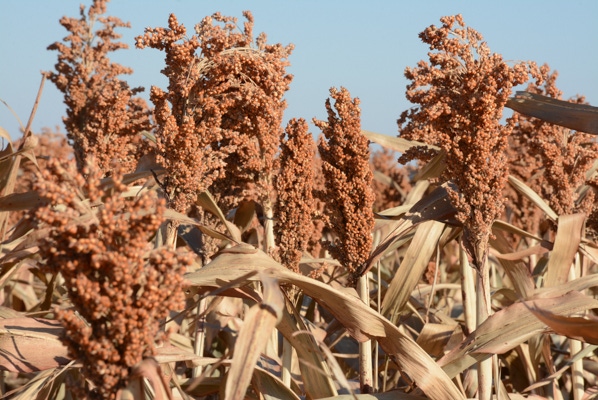
Hot and mostly dry conditions reported across the Lower Rio Grande Valley are stressing dryland crops and keeping growers irrigating, according to an IPM Extension Agent.
“Cotton is in full bloom and we are seeing good boll set in most areas,” writes Daielle Sekula, in her June Pest Cast Row Crops IPM newsletter. “I noticed some cotton shedding its squares after this irrigation.”
Cotton pre-bloom is looking clean of fleahoppers, but Sekula encourages growers with late-planted cotton to continue to monitor their fields. “I have received a couple of reports of cotton being treated for tarnished plantbugs feeding on immature bolls along the river.”
The threshold for tarnished plantbugs is 10 per 100 sweeps. “We were sweep netting in the La Sara and Lyford areas and picked up on zero tarnished plantbugs per 100 sweeps, but as we moved to the Sebastian and Santa Rosa areas we were getting about three tarnished plantbugs per 100 sweeps,” she reports.
Though the tarnished plantbugs are not at threshold, Sekula says they are moving into cotton fields with immature bolls. “In those areas, sorghum had been sprayed with glyphosate and was drying up and getting ready for harvest, so I suspect they are migrating out of there and also out of the sesame into the cotton.”
While adult tarnished plantbugs are winged and brown in color, mottled with red, yellow and black, nymphs, though similar, lack wings and are greenish in color with black spots, she writes. “Females lay whitish eggs inserted into the host plant and hatch in about eight days. From egg to adult the tarnished plant bug life cycle is about three to four weeks and produce five generations a year.”
Last week, Sekula also spotted Verde bugs in Bayview and the Los Fresnos areas. Both Verde bugs and tarnished plantbugs pierce immature bolls and squares resulting in boll malformation to complete fruit loss, she says. Verde plantbug adults are about a quarter-inch long in size and are light green in color with long antennae and red eyes.
“Cotton along the river was sprayed last week for whiteflies as many adults and now immatures have been present. Growers with cotton planted along the river near sesame need to be proactive in controlling whiteflies as they will overcrowd on the underside of sesame leaves and then migrate to nearby cotton fields to continue feeding,” Sekula says.
GRAIN SORGHUM
Last week, Sekula said there was a lot of midge in flowering sorghum as fields were being treated, as well as heavy headworm pressure in soft-dough sorghum along the coast in the Bayview, Los Fresnos and Progreso areas. “I also saw many rice stink bugs present in soft-dough sorghum but most were being controlled along with midge or headworm applications,” she writes. “Sugarcane aphid pressure across the Valley has calmed down as we gear up for harvest. I predict a second peak or rise in sugarcane aphid populations by the end of June, so late sorghum and even sorghum prior to harvest, should be scouted to avoid a sticky situation, literally.”
SESAME
Last week, Sekula and her staff found mirids (Nesidiocoris tenuis) in sesame across the Valley. Though the mirids populations were not high, she says growers will need to keep a close eye on their sesame, especially with the high heat.
“While no threshold has been established for N. tenuis we did notice in July of 2015 that it took as little as three to five mirids per sesame terminal per plant to cause significant damage,” says Sekula. “Right now, I have only seen that in a handful of fields and there were many whiteflies present for them to feed on. The majority of the Valley has mirids present but at an average of one per plant and the sesame plants look very healthy.”
Mirids, a type of plantbug, suck plant juices and can cause necrotic damage and stunting of growth to the sesame plant, as well as, injury to the pods. N. tenuis mirids adults and nymphs are lime green in color measuring no more than five millimeter in size. The adults, when their wings are closed, make a heart shape that upon close observation is easy to spot.
Sekula writes, Necrotic damage will look like a reddish/brown scaring to the plant tissue along the stem, leaves and on the seed pods. Mirids N. tenuis also can be predators to whiteflies feeding on both adults and immatures in the lower canopies of the sesame when present. However, mirids can develop successfully on the sesame plant alone and will feed on the plant more when they have depleted their food source (in this case whiteflies) or there is an abundance in mirids populations.
Signs of high mirids pressure feeding on the plants is yellowing on the leaves and brownish necrotic damage and the curling under of the leaves. “You will want to monitor for mirids and treat if necessary since their feeding can hurt yield potential. Products labeled on sesame that control mirids are Transform and Mustang Maxx,” Sekula says.
For more information, contact Sekula at [email protected].
About the Author(s)
You May Also Like






